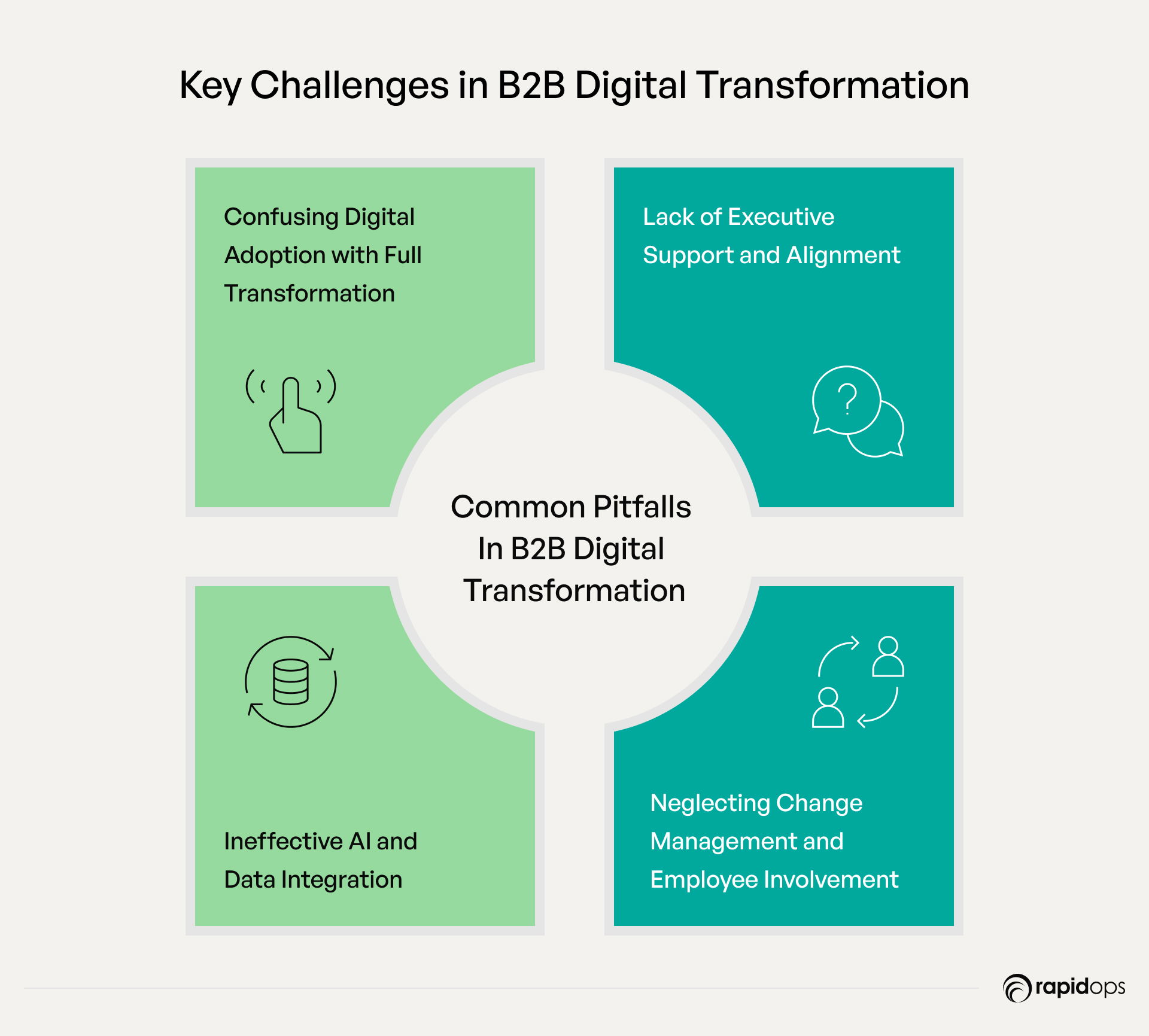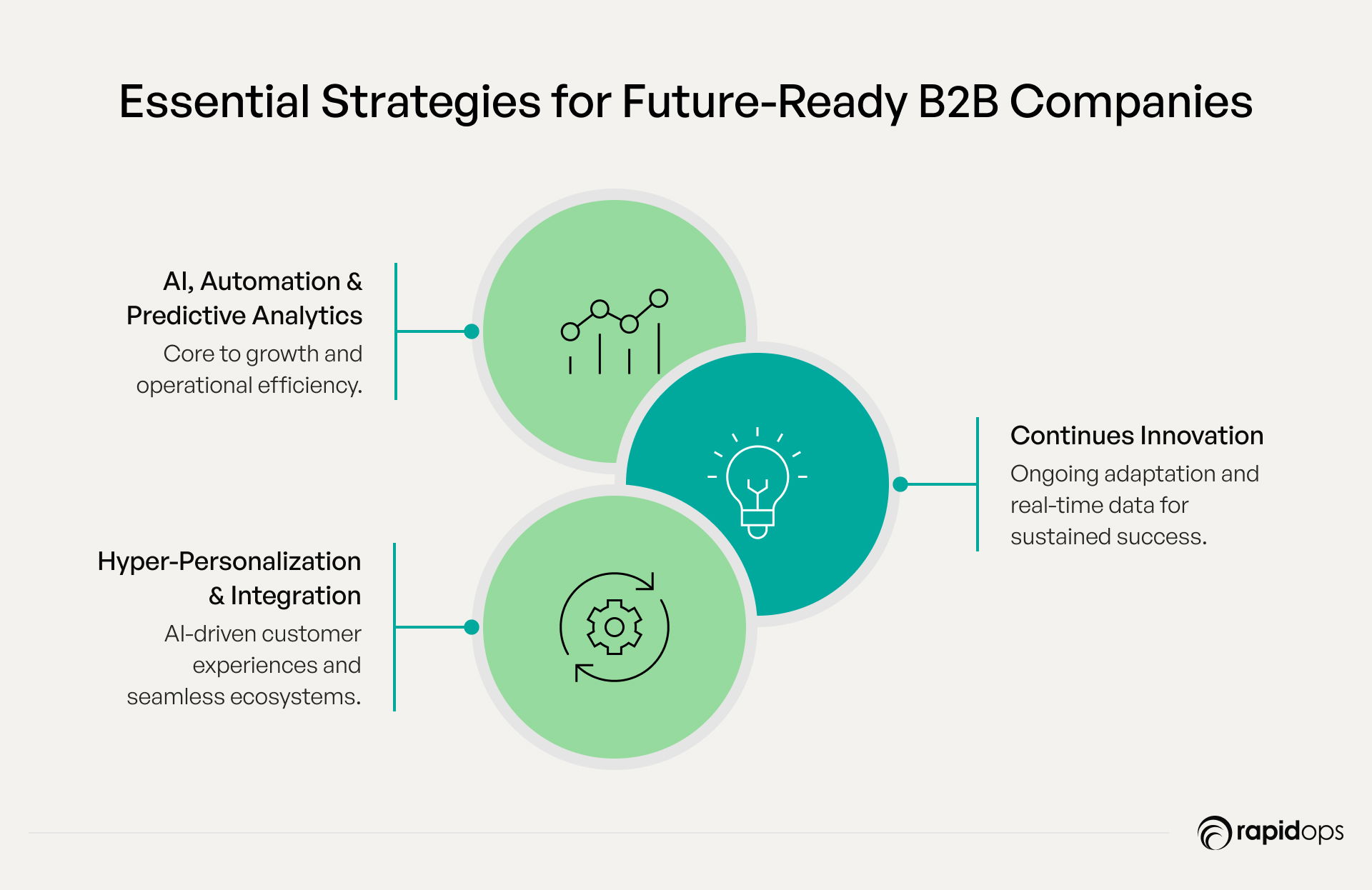- Transformation
- 11 min read
- January 2025
Why B2B Digital Transformation Needs a Different Approach
Is your organization equipped to meet the evolving demands of digital transformation in B2B?
In an era defined by increasing complexity and fierce competition, digital transformation is no longer a choice; it’s a strategic necessity. Yet, for B2B companies, the path to modernization presents unique challenges that extend beyond adopting new technologies.
B2B enterprises often grapple with lengthy sales cycles, multi-stakeholder decision-making, and intricate procurement processes, which can inhibit growth. Gartner research indicates that 77% of B2B buyers deem their purchasing journey highly complex, highlighting the need for transformation strategies that address deeper, systemic issues, not just superficial tech upgrades.
Without a deliberate, comprehensive modernization strategy, organizations risk falling into operational silos, slow decision-making, and missed market opportunities. To remain competitive, B2B companies must embed AI, automation, and data-driven decision-making into their core operations, creating systems that are agile, scalable, and resilient.
This article delves into the complexities of B2B digital transformation, uncovering why traditional approaches often fall short, key pillars for success, common pitfalls to avoid, and actionable steps for driving lasting growth.
What Makes B2B Digital Transformation Different?
B2B digital transformation revolves around complex sales cycles, long-term partnerships, and deeply integrated systems. Success depends on a strategic approach that prioritizes relationship-building, operational efficiency, and seamless technology adoption, factors that set it apart from consumer-driven models.
I. Extended Decision-Making Cycles Demand Process-Driven Transformation
- With sales cycles ranging from 6 to 18 months, B2B purchases involve multiple stakeholders across procurement, finance, and operations.
- Digital transformation must enhance multi-stage decision-making, integrating predictive analytics and automation to streamline approvals and workflows.
II. Relationship-Driven Sales Require Digital Enablement, Not Just Efficiency Gains
- 75% of B2B buyers prioritize long-term partnerships over pricing, requiring digital solutions that enhance trust and engagement rather than just transaction speed.
- Advanced CRM systems, AI-driven account management, and digital self-service platforms are becoming essential for sustaining client relationships at scale.
III. Customization Is Not a Differentiator, It’s an Expectation
- B2B solutions must integrate seamlessly with ERP, supply chain management, and financial systems, off-the-shelf tools rarely meet enterprise needs.
- 67% of B2B buyers expect tailored solutions, hyper-personalization, AI-driven recommendations, and modular architectures critical.
IV. Regulatory Compliance as a Digital Imperative
- Industries such as finance, healthcare, and manufacturing operate under stringent regulatory frameworks (GDPR, HIPAA, ISO), where digital adoption must align with compliance mandates.
- Secure data management, AI-driven risk assessment, and governance-focused automation are essential for sustainable transformation.
Why This Matters
To succeed in B2B digital transformation, it’s essential to recognize the unique dynamics at play and craft strategies that respond directly to the specific challenges and opportunities of your industry, ensuring sustainable growth and a competitive edge.
Why Most B2B Digital Strategies Fail (And How to Fix Them)
Despite substantial investments in digital transformation, many B2B enterprises fail to achieve measurable impact. The primary reason? A focus on front-end enhancements while neglecting process automation, system integration, and data intelligence—the true backbone of B2B operations. This fragmented approach leads to inefficiencies, slow decision-making, and minimal ROI.
To drive meaningful transformation, businesses must go beyond UI/UX upgrades and embed technology into core operations, ensuring scalable, data-driven innovation.
1. Prioritizing Front-End Over Backend Optimization
Why it fails
Many B2B companies invest in UI/UX improvements, e-commerce platforms, and customer engagement tools while neglecting procurement, supply chain, and compliance automation. This results in operational bottlenecks and fragmented workflows, where front-end improvements fail to create true efficiency gains.
How you can overcome it
- AI-Powered Process Automation: Automate procurement, contract management, and compliance workflows to improve operational speed.
- End-to-End System Integration: Ensure seamless data flow across CRMs, ERPs, and supply chain systems for enterprise-wide visibility.
- Intelligent Workflow Optimization: Use AI-driven decision-making to eliminate inefficiencies and enhance risk management.
2. Underutilization of AI, Automation, and Data
Why it fails
B2B enterprises often treat AI and automation as optional enhancements rather than core operational drivers. As a result, they continue to rely on manual workflows and fragmented data, leading to poor demand forecasting, inefficient sales processes, and missed growth opportunities.
How you can overcome it
- AI-Powered Demand Forecasting: Leverage machine learning models to predict market trends, optimizing inventory and procurement.
- Automated Sales Intelligence: Use AI-driven insights to prioritize high-value accounts and personalize engagement strategies.
- Real-Time Data Integration: Ensure CRMs, ERPs, and analytics platforms work cohesively, providing actionable insights.
3. Misalignment Between Digital Transformation and Business Goals
Why it fails
Many B2B organizations adopt technology without aligning it to business KPIs, leading to:
- Fragmented adoption: Unconnected tools create inefficiencies.
- Low ROI: Investments fail to deliver tangible business outcomes.
- Resistance from stakeholders: Employees struggle to adapt without a clear transformation strategy.
How you can overcome it
- Business-Centric Digital Strategy: Align digital investments with KPIs like revenue growth, customer retention, and cost reduction.
- Cross-Functional Leadership Alignment: Ensure business units, not just IT teams, drive transformation.
- Agile, Measurable Implementation: Roll out digital initiatives in phases with clear success metrics.
4. Failure to Invest in Self-Service Digital Tools for B2B Buyers
Why it fails
B2B buyers demand faster, frictionless procurement, yet many organizations still rely on manual order placements, approval cycles, and slow customer support. These inefficiencies result in longer sales cycles, decreased satisfaction, and lost business opportunities.
How you can overcome it
- AI-Powered Self-Service Portals: Enable real-time contract renewals, pricing adjustments, and automated inventory tracking.
- Omnichannel Engagement: Use chatbots, mobile apps, and automated workflows to enhance user experience.
- Intelligent Order Management: Implement AI-driven automation to streamline high-volume transactions and reduce delays.
These failure points underscore the need for a structured, strategic transformation roadmap that aligns digital initiatives with business goals, operational efficiency, and long-term scalability. The following pillars define a successful B2B digital transformation strategy that delivers real impact.
Key Pillars of a Successful B2B Digital Transformation Strategy
A successful B2B digital transformation strategy embeds AI, automation, and seamless integration to navigate complex sales cycles and multi-stakeholder decision-making. Leading companies use AI-driven personalization, process automation, and real-time analytics to drive agility, efficiency, and sustainable growth.
1. AI-Driven Personalization for B2B Buyers
B2B customers demand hyper-personalized interactions, yet 77% describe their purchasing journey as complex and time-consuming (Gartner). AI-driven account-based selling transforms engagement by anticipating customer needs, predicting churn risks, and personalizing touchpoints at scale.
- Strategic Impact: AI-powered CRM systems leverage machine learning to identify high-value accounts, forecast revenue potential, and optimize outreach strategies, shifting sales from reactive to predictive.
- Case in Action: A leading enterprise software provider implemented an AI-driven recommendation engine, increasing customer lifetime value by 25% through targeted upselling and retention strategies.
2. Process Automation for Supply Chain & Operations
Operational inefficiencies erode margins, and 70% of B2B executives cite supply chain disruptions as a top business risk (McKinsey). Process automation through AI, RPA (robotic process automation), and IoT enhances supply chain agility by eliminating bottlenecks and improving forecasting accuracy.
- Strategic Impact: Intelligent automation in procurement, inventory, and order fulfillment reduces costs, accelerates cycle times, and minimizes human error.
- Case in Action: A global logistics firm deployed AI-driven demand forecasting, reducing supply chain disruptions by 30% and achieving 15% cost savings in inventory management.
3. Data-First Decision-Making with Real-Time Analytics
In a B2B environment where market conditions shift rapidly, data silos lead to fragmented decision-making. Organizations that use predictive analytics outperform peers by 20% in EBITDA growth (BCG). AI-driven analytics unlock real-time insights for demand forecasting, risk assessment, and pricing optimization.
- Strategic Impact: Data-driven enterprises can identify market shifts earlier, optimize resource allocation, and drive competitive differentiation by leveraging AI-powered insights.
- Case in Action: A leading industrial manufacturer integrated AI-driven demand planning, reducing stockouts by 35% and improving production planning efficiency by 20%.
4. Seamless Integration with Enterprise Systems
Many B2B firms struggle with legacy infrastructure that creates silos and hinders scalability. 90% of enterprises cite integration challenges as a primary barrier to digital transformation (Forrester). Cloud-based API integrations provide a unified ecosystem that connects CRM, ERP, and procurement systems to enable a seamless data flow.
- Strategic Impact: Companies that achieve cross-functional system integration reduce IT complexity, accelerate time-to-value in digital initiatives, and enhance productivity while cutting operational costs through streamlined workflows and automation.
- Case in Action: A manufacturing firm integrated AI-powered compliance monitoring across its ERP and CRM systems, streamlining production workflows and reducing regulatory reporting errors, ensuring seamless data flow and operational efficiency.
5. Customer-Centric Digital Experiences for Long-Term Relationships
In B2B, 85% of buyers expect the same seamless experience as in B2C transactions (PwC). AI-powered self-service platforms, chatbots, and personalized customer portals enable frictionless digital interactions, reducing dependency on sales teams while enhancing customer satisfaction.
- Strategic Impact: Intelligent automation in customer service improves response times, enhances engagement, and strengthens long-term business relationships.
- Case in Action: A cloud solutions provider implemented AI virtual assistants, reducing B2B customer support costs by 40% while improving resolution speed by 50%.
Driving B2B Digital Transformation with a Strategic Roadmap
B2B digital transformation demands more than technology adoption, it requires a structured roadmap that aligns strategy with execution. Companies that embed AI-driven decision-making, automation, and system integration will streamline operations, improve responsiveness, and drive measurable business impact. The key to success lies in execution, transforming at scale, adapting dynamically, and sustaining a competitive edge.
Common Pitfalls in B2B Digital Transformation (and How to Avoid Them)
Despite significant investments, only 30% of digital transformation initiatives achieve their intended business objectives (McKinsey). This failure often stems from execution missteps, rather than strategy misalignment alone. Below are four key pitfalls that hinder transformation success and how to mitigate them.

1. Mistaking Digital Adoption for Real Transformation
Why it happens
Many companies mistake digital adoption for transformation. They roll out AI-powered CRMs, automation tools, or cloud solutions without a roadmap, resulting in disconnected initiatives and minimal impact.
How to avoid it
- Tie technology investments to measurable business outcomes (e.g., revenue growth, cost reduction, operational efficiency).
- Define success metrics beyond adoption rates, focus on customer retention, productivity gains, and revenue acceleration.
- Ensure digital tools integrate across departments sales, marketing, supply chain, and finance must function cohesively.
Example
A manufacturing firm digitized its customer service platform but failed to integrate it with ERP and supply chain systems. The result? Faster response times but continued inefficiencies in order fulfillment. A true transformation would have required full front-end and back-end integration.
2. Lack of Executive Buy-In and Alignment
Why it happens
Without C-suite sponsorship and cross-functional alignment, digital transformation becomes an IT-led initiative rather than a business-driven strategy. This lack of leadership involvement often leads to.
- Budget misallocation: Prioritizing tech upgrades without addressing process inefficiencies.
- Resistance from employees: Change is seen as disruptive rather than enabling.
- Fragmented execution: Departments operate in silos with no unified vision.
How to avoid It
- Appoint a Chief Digital Officer (CDO) to drive transformation across business units.
- Ensure board-level engagement by linking digital initiatives directly to revenue, customer acquisition, and cost optimization.
- Break silos by creating cross-functional transformation teams (IT, sales, operations, finance).
Example
A logistics company invested in an AI-driven route optimization system but faced resistance from leadership due to workflow disruptions. By engaging executives early and demonstrating cost savings, the company secured buy-in and successfully scaled automation across operations.
3. Failure to Prioritize AI and Data Integration
Why it happens
B2B enterprises generate massive volumes of unstructured data, yet many fail to establish centralized data strategies. 85% of AI projects fail due to poor data governance (Gartner).
How to avoid It
- Implement data governance frameworks for structured, accessible data.
- Invest in AI-driven analytics platforms that unify customer, sales, and operational data.
- Prioritize real-time integration across CRMs, ERPs, and supply chain systems to enable predictive decision-making.
Example
A B2B eCommerce company implemented an AI-powered recommendation engine but failed to integrate it with real-time inventory data, resulting in inaccurate product suggestions and lost revenue. By ensuring seamless data integration, they improved conversion rates and reduced supply chain inefficiencies.
4. Underestimating Change Management
Why it happens
Digital transformation is as much about people and processes as it is about technology. Many B2B enterprises fail to prepare employees for workflow changes, leading to:
- Resistance to adoption.
- Misuse or underutilization of new tools.
- Operational disruptions impact efficiency.
How to avoid it
- Develop structured change management programs with training and clear communication.
- Involve employees early in the transformation process to demonstrate value.
- Foster a culture of innovation where teams are encouraged to experiment and adapt.
Example
A global industrial supplier introduced AI-driven procurement automation, but employees feared job displacement. By involving them in the implementation process and showcasing how AI streamlined tasks, the company achieved 90% adoption within six months.
To succeed in B2B digital transformation, businesses must move beyond surface-level adoption and embrace a strategy that integrates AI, automation, and data-driven decision-making. The key is not just digital change, but transformation that drives measurable business impact and long-term growth.
Strategic Considerations for Future-Ready B2B Companies
To remain competitive, B2B companies must shift from one-time digital transformation initiatives to continuous innovation. Future success hinges on integrating AI, automation, and predictive analytics into core operations while staying agile and responsive to market demands.

1. AI, Automation, and Predictive Analytics: Essential for Growth
AI and automation are no longer optional. They are core to optimizing B2B operations and driving sustainable growth. By embedding AI in critical functions such as demand forecasting, predictive maintenance, and workflow automation, companies can reduce costs, streamline operations, and enhance customer satisfaction.
Predictive analytics further empowers decision-makers with data-backed insights, enabling them to anticipate trends and respond proactively.
2. Continuous Innovation for Long-Term Success
Digital transformation should be viewed as a continuous, evolving process. Companies that commit to ongoing innovation, not just isolated projects, can ensure sustained success.
A culture of agility, supported by real-time data and iterative improvements, is key to navigating the complexities of the modern business landscape. Innovation labs and cross-functional collaboration are essential for adapting to new technologies and responding to shifting market conditions.
3. The Future of B2B Commerce: Hyper-Personalization and Integration
B2B commerce is moving toward a future dominated by AI-driven personalization and fully integrated digital ecosystems. Sales teams that leverage AI to anticipate customer needs and deliver hyper-personalized experiences will strengthen customer loyalty and accelerate the sales cycle.
Moreover, integrated ecosystems allow for seamless collaboration across stakeholders, improving efficiency and providing a cohesive customer experience across touchpoints.
The future of B2B success depends on AI, automation, and innovation. Companies that integrate these will streamline operations, drive growth, and stay resilient in a complex market. Now is the time for leaders to adopt a strategic digital approach.
Start Your Digital Transformation Journey: Assess, Optimize, and Grow
For B2B organizations, fragmented systems, inefficiencies, and slow decision-making aren’t just challenges, they’re roadblocks to growth. While digital transformation offers a path forward, knowing where to start can feel overwhelming.
Imagine a business where data flows seamlessly, AI automates repetitive tasks, and every decision is backed by real-time insights. This isn’t just about adopting technology, it’s about creating a smarter, more agile organization.
Take the First Step with Confidence
Transformation begins with assessing your current systems. Are they aligned with your long-term vision? Where are inefficiencies slowing you down? Identifying these gaps helps you focus on high-impact opportunities. You don’t need all the answers today, just a clear, strategic first step.
Turn Vision into Action
The businesses that succeed aren’t waiting for the perfect moment, they’re exploring new opportunities now. Book a free consultation to discuss how AI, automation, and data-driven strategies can drive meaningful change for your business. The future is shaped by those who start early, let's explore how to begin your journey today.
What’s Inside
- What Makes B2B Digital Transformation Different?
- Why Most B2B Digital Strategies Fail (And How to Fix Them)
- Key Pillars of a Successful B2B Digital Transformation Strategy
- Common Pitfalls in B2B Digital Transformation (and How to Avoid Them)
- Strategic Considerations for Future-Ready B2B Companies
- Start Your Digital Transformation Journey: Assess, Optimize, and Grow




